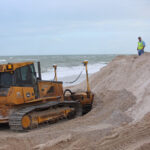VERO BEACH — The long-awaited barrier island beach replenishment project is set to begin in about two weeks, but on Tuesday, even before a grain of sand is trucked across the Wabasso Causeway, the Board of County Commissioners will be faced with the fact that price tag could go up by more than $1.7 million.
The contractor hired on a $7.27 million contract to place some 200,000 cubic yards of sand onto the beaches between John’s Island and Golden Sands Park says it needs $984,000 more to do the work.
The consultants in charge of administering the sea turtle “test plan,” collecting environmental data regarding the trucked-in sand has also come back for $738,000 more to do that work. These additional charges take the total sand project bill to $9 million — about $100,000 more than if the county had gone with pumped-in sand at a bid of $8.9 million.
About half of the added $984,000 charge from Ranger Construction is for spot testing of sand, and demobilizing and restarting crews over the two seasons it is now going to take to complete the job. But the other half, about $470,000, consists of fees to “process” sand, and that is likely to become a point of contention for a cash-strapped county.
“They said they could produce beach-quality sand,” said Public Works Director Chris Mora said. “That’s what they bid on and that’s what the contract provides for, so we need to make sure the extra cost is justified.”
Commissioner Bob Solari expressed skepticism about such a large change order, and said he wants to see the costs broken down before approving more money at a scheduled Feb. 2 commission meeting.
“At the last commission meeting , I was very clear that I wanted a very detailed financial analysis as to where these costs are coming from and why they were necessary,” Solari said.
All this leaves a bit uncertain the plan to have thousands of dump trucks in two weeks begin the steady march over the Wabasso Causeway, shoring up the beaches with trucked-in sand in what will be a two-phase project, with the season being Nov. 1 to May 1.
Commissioners, including Chairman Peter O’Bryan, who serves as commission liaison to the Beaches and Shores Preservation Committee, will be looking closely at this nearly half-million dollar add-on to make sure it’s not designed to compensate sand miners for things that should be figured in as a cost of doing business – especially if those things were done only in hopes of getting the contract and not as a result of getting it.
Mining beach sand was a gamble that local sand miners took, banking on calling in political chits and appealing to angst over unemployment to keep the lucrative contract on the Treasure Coast and not have the money go to Illinois-based Great Lakes Dredge, the company which completed the last two beach sand projects with piped-in sand from off-shore.
The gamble seems to have paid off as the project is going forward, but the opportunity cost meant keeping mining operations pristine, keeping dredges digging deep and keeping lands devoted to mining beach sand instead of garden-variety fill sand for roads, parking lots and drain fields. Ranch Road Lake sand mine owner Steve Smith, for example, set aside all other types of sand mining at his site and began dredging sand for the county project as early as the fall of 2009.
He brought in a dredge and a crew to operate it at a cost of about $40,000 per month, several months before the county had made even the promise of a permit.
Now, Smith is claiming that he needed to bring in a second dredge to produce the quality and quantity of sand the county needed to meet specifications. He also had to excavate an area of his land – the future site of an upscale, lakeside housing development when the real estate market turns around – to mine the right type of sand.
“Does that need to bring in a second dredge to process the sand justify a change order?” Mora said. “We’re just not sure.”
The Gamble
In September, the Board of County Commissioners decided to hire Ranger Construction to handle the job, which is the largest-scale beach construction project using upland sand ever attempted. In two phases over nearly a year’s time, Ranger will be getting nearly 472,000 cubic yards of sands from the Ranch Road Lake Sand Mine off 82nd Avenue and 69th Street and the Henry Fischer and Sons sand mine off Oslo Road west of town.
The original plan called for trucks going over all three causeways. A change in logistics coupled with angry complaints from the City of Vero Beach and the Town of Indian River Shores has helped channel the truck traffic of about one dump truck per minute exclusively over the Wabasso Causeway. Staging areas will be Wabasso Beach Park, Golden Sands Park, Turtle Trail beach access and Seagrape Trail beach access.
Only 202,000 cubic yards will be placed this year in the southernmost part of the re-nourishment zone. Before the second phase is approved, the trucked-in sand will have to pass muster with the Florida Department of Environmental Protection, Florida Fish and Wildlife Commission and the U.S. Army Corps of Engineers. Phase two extends from Golden Sands Park north to Treasure Shores Park and encompasses part of the Archie Carr National Wildlife Refuge.
The whole area being replenished is of vital importance to the sea turtle population, not only in Florida, but nationally, according to the county’s turtle expert, Rick Herran of the Coastal Engineering division of Public Works. Herran and coastal engineer James Gray will be taking the lead on the beach sand project.
“There has to be a member of the county engineering staff there 10 hours a day from 7 a.m. to 5 p.m. to inspect every truckload of sand,” Mora said. Without Gorham, Mora said he can call on engineers from other divisions of Public Works to make sure that requirement is fulfilled.
Now that the county has a draft permit and has advertised the impending project, it must observe a 14-day mandatory waiting period, during which public comment will be sought.
“Hopefully the comment period will be uneventful, but if a comment is received which has some merit, DEP will evaluate the comment and it could potentially go to an administrative hearings and could delay us getting the notice to proceed,” Mora said. The public comment period expires on Feb. 5. On Feb. 8, the county must host a Preconstruction Conference. If all goes well and FDEP signs off on a notice to proceed, Mora said trucks are expected to start dumping sand on the beach on Feb. 9.
This schedule gives Ranger Construction a total of 56 weekdays to get the work done. The total could increase to 65 days should Saturdays be included in the schedule. Ranger has stated that it needs 47 perfect days with no weather concerns or equipment failures to complete this year’s work on the project.
“We don’t plan to use Saturdays,” Mora said. “But if it gets toward the end and we’ve had a lot of bad weather days and it’s getting tight, we may have to expand to Saturdays to meet the May 1 deadline.” May 1 is the last day when, by environmental standards, construction can be done on the beach without causing undo hardship on the nesting and hatching of sea turtles.
Barrier island residents have been waiting for more than five years to get sand on their badly eroded beaches, but they’re not the only ones watching this project very closely. Mora explained that there are “just a lot of eyes looking at this,” referring to the fact that the county will be using upland sand from sand mines on a large-scale re-nourishment project and therefore embarking on relatively untested environmental and engineering territory.
“We’ve had interest from Ft. Myers and from Broward County in what we’re doing here because it’s the largest truck fill project ever been attempted on the beach,” Mora said. “A lot of people are looking at how we’re doing it and how we’re satisfying the Army Corps of Engineers and Fish and Wildlife.”
Traditionally, beach re-nourishment in Florida has been accomplished using off-shore sand pumped in by a dredge, but the county opted to use local sand miners for this project to help boost the economy and provide much-needed jobs for construction workers and truckers.
To ensure that the use of upland sand does not negatively impact the off-shore reef or the sea turtles that call Indian River County home, state and federal regulators have mandated that the county implement what’s being called the turtle “test plan,” which involves more intricate data collection and analysis than the standard three-year monitoring regimen, which was already figured in the cost of the project at about $1.1 million.
Over the coming weeks, Mora said he will have to bring yet another new pricey item to the commissioners, this one a work order for consultant Coastal Tech to conduct and oversee the turtle “test plan.”
If the Commissioners had gone the route of hiring Great Lakes Dredge to pump in sand — as it did during previous projects near Sebastian Inlet and Castaway Cove — there would have been no need for exceptionally stringent monitoring, no extra paperwork for county staff and no mid-project approval needed by regulators to proceed with the final phase – and the project would most likely already be completed. Once mobilized, the dredger takes about 45 days to pump the sand and can work 24 hours a day, if needed. But the $8.9 million bid from Great Lakes, which was only good for 90 days, has expired and it would probably be too late in the year now to bring a mobilize a dredge team, so it appears as if the county has no choice but to move forward with upland sand, despite the increased scrutiny and cost.
The hundreds of high-paying jobs promised by sand miners during the emotionally charged debates over upland vs. off-shore sand also have turned out to be overwhelmingly temporary, contract trucking jobs with no fringe benefits.
Due to the seasonal nature of the project, this county contract will leave workers without paychecks and back amongst the 14 percent unemployed again in about three months.





